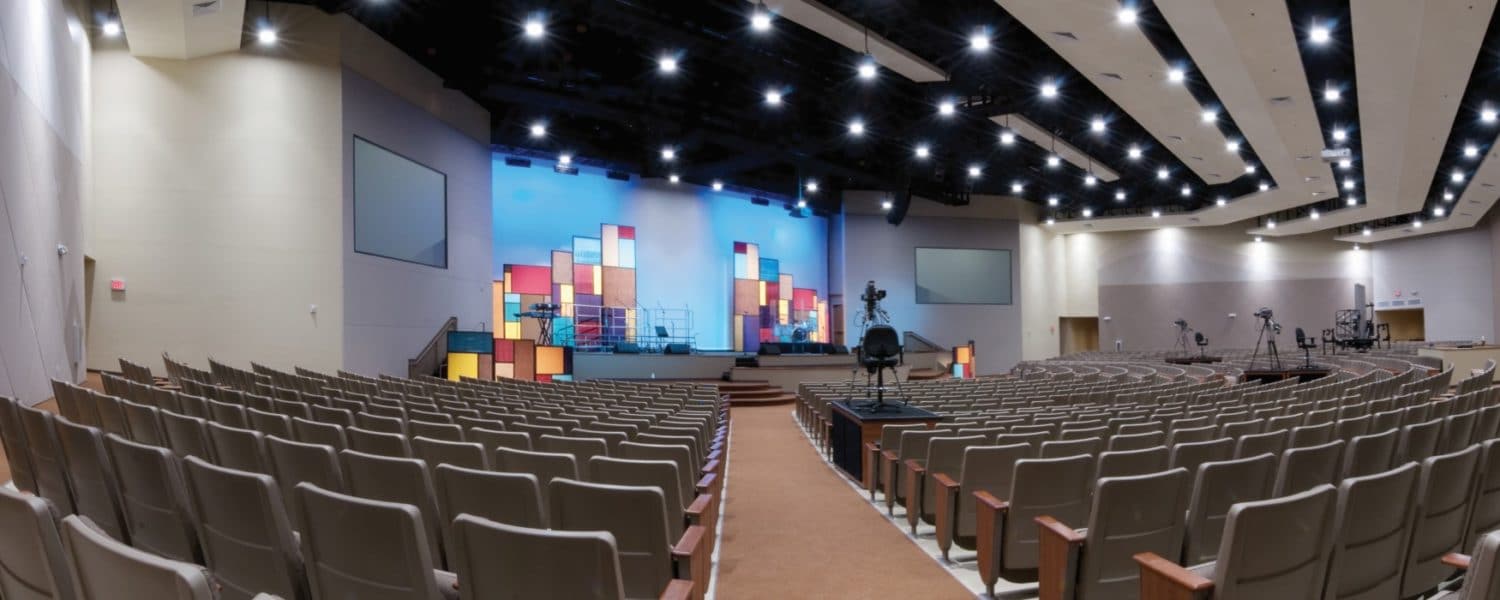By Ryan Nelson
As the former art director at Mars Hill Church, Eleazar Ruiz is sensitive to how physical elements of a room or a service affect our posture towards God, our attitude towards worship, and our experience of a sermon.
“I visited an Episcopal Cathedral in Seattle, and the design and silence of the room made me feel like I had to take my hat off to be there,” says Ruiz, a senior designer at Faithlife. “The silence of it made me feel reverent—it was a place of prayer. A holy place. The actions I was taking were not normal to me, but the setting pushed me to behave in a particular way.”
The intent of good church design isn’t to manipulate how people feel, but to challenge us to think about God, and to inspire us to worship him.
“Interior design is always communicating something,” Ruiz says. “One of the reasons cathedrals are so tall with such high ceilings is to make you feel small. You’re coming to these places to worship a huge God.”
For Ruiz, understanding the importance of interior design all begins with Scripture—and the God who creates and inspires beautiful things.
The Biblical Precedent for Interior Design
“If you go back to Exodus 31,” Ruiz says, “God gave two men the gift of craftsmanship.”
In the Bible, God clearly cares about how things look and feel, and what we say about him through the things we create.
“God gifted people with the skills to design things as they were intended to be designed, with the meaning and purpose that he intended,” Ruiz says. “As an artist and a designer, it gives me purpose and meaning to see in Scripture that God cares about aesthetics.”
God had a vision for how the places, people, and rituals we associate with him appear.
“The veil at the entrance to the Holy of Holies had a purpose aesthetically,” Ruiz says, “but it also symbolized the separation between us and God. Something aesthetic communicated something theological.”
Ruiz wants churches to understand that the choices we make about aesthetics really come down to this: “Do we care about communicating to the senses? The senses we can’t engage with other mediums. Do you care to communicate to my eyes, ears, and nose, and tell me something further about God?”
How Aesthetics Affect Your Congregation
“The same way we try to create a romantic setting for our spouses—not super light, not super dark, use the candles—lighting communicates temperature and how inviting your room is,” Ruiz says.
Lighting affects your perception of what you hear, see, and smell—do the things our senses experience fit together?
“Fluorescent lighting can create a corporate feel. It doesn’t feel reverent, so it seems out of place in church.”
We all know that physical posture affects how well we pay attention—it doesn’t just tell the speaker if we’re listening. Every time a teacher says, “Sit up straight in your chair, please,” or a parent says, “Look at me when I’m talking to you,” they’re appealing to the power of physical postures. It’s not just about respecting the speaker. It puts the listener in a better position to listen, comprehend, and process what they’re hearing. It shifts their focus.
“The actions the design makes you do communicates something to you. It encourages you to be reverent or disrespectful,” he says.
At the church he visited in Seattle, Ruiz noticed how other design elements affected his spiritual experience throughout the service. Details of the architecture also carried subtle and not-so-subtle nods to theological truths, presumably to reinforce important teachings of the church.
“I saw 12 chandeliers,” Ruiz says. “There were four on each of the two ends and four in the middle. Those chandeliers had twelve lights on the outer rim and three lights in the center.”
Without a minister saying a word, Ruiz was reflecting on concepts he might hear unpacked in a message, or revealed in his personal study.
He says, “I look at it and I know where the twelve came from. I know where the three came from. It’s all intentional.”
Since design is so connected to our perception, even simple changes to the look and feel of a room can affect your congregation.
“Change itself causes people to pay attention,” Ruiz says. “When you switch from one series to another, if you have an illustration or something different on the stage, that causes people to pay attention, to be interested, to be curious.”
No change is too small for you to consider how it affects people.
He says, “Even the bulletin, how it’s designed, what’s in there, what it’s printed on, that communicates something about the experience.”
For most churches, good design is about deciding what you want to communicate, or what you want people to do or feel, and then working from there.
“Sometimes worship leaders stop singing in the middle of a song so that people sing,” Ruiz says. “The lack of vocals pushes people to sing.”
If you want to encourage people to behave a certain way, or feel comfortable in a particular setting or posture, design can help you encourage that. And the best part is that you don’t need a million-dollar budget to take an intentional approach to design.
Interior Design for the Small Church
“There’s always somebody in your church who cares about design. At least one person.” Ruiz says. “Whether they’re talented or not is a completely different question, but there is always someone who cares, no matter how small your church is.”
Small churches are still capable of building a design team.
He says, “For small churches, I say use that one person. There’s someone who has been wanting to serve in that way but hasn’t found their place, or maybe hasn’t felt valuable—like me.”
The creatives in your church need to know that their passion (or even just concern) for good design is important to your church and to God—because it really does affect people. If you don’t validate and affirm that calling, your church—and the body of Christ—could be missing out on something powerful and beautiful that God is trying to stir up in your midst.
“I talk to a lot of designers who are discouraged about not being used within the church,” Ruiz says. “They just need to see that you care, that what they care about is valuable, and that you’re looking for someone.”
Sometimes that affirmation is all it takes to get things moving in your church.
“Usually from there, you can go, because that person feels empowered,” Ruiz says. “They have ownership over that particular area of the church. What they’re going to do is find more people like them. And a year later you have a team.”
As your design team expands, the design of your church can more closely reflect the diversity of your church.
“I think there’s something beautiful about having more than one person involved in the process because then design becomes an expression of the church and the body, and not just an expression of one person,” he says.
And it’s okay if they aren’t professionals.
“I think whether they’re talented or not, it’s an expression of your church,” Ruiz says. “It’s your people, creating things and expressing things about the family they’re a part of—which is your church.”
Does Your Church’s Design Reflect Your People?
What you see when you first set foot in someone’s home tells you a lot about them, and it can change or confirm your perceptions about who they are depending on how it aligns with what you’ve already experienced.
“It’s rare that you go into someone’s home and don’t see pictures of their family,” Ruiz says. “Are people going to see your family in the wall, in the stage, in the colors? A home without pictures is a sad place.”
How your family expresses itself visually certainly changes as your budget grows. Megachurches can afford to dedicate someone to design and pay them for it. But whether your church is big or small, Ruiz says, “The challenge for both is the same: How do I communicate this message through interior design?”
The answer your church provides depends on what you have available.
“Smaller churches, because of budget limitations, tend to only have one look. Always,” Ruiz says. “With different church sizes, the frequency of changes to design changes. But occasionally you find a smaller church, like mine, where designers volunteer and help you do more with less.”
It’s up to your church to decide how to use the creative people you’ve been given.
“Design in general is a resource, like money is,” Ruiz says. “It should be stewarded well. The same way you can use money to buy Bibles to distribute to new believers, design can be used to communicate things about God to your congregation.”
If your church doesn’t have a single volunteer or dollar to apply to design, it’s not going to unravel your ministry. But it may be harder for people to identify your church identity, and to see God as you intend to reveal him.
“Having no interior design is like not having a sermon podcast,” Ruiz says. “I don’t know if it’s a missed opportunity as much as it is that your church can be doing more.”
Some people are visual learners. But even those of us who aren’t can tell when what we’re hearing doesn’t fit with what we see.
Which is probably why God cares about design—and your church should, too.
Ryan Nelson is a marketing copywriter for Faithlife, the makers of Logos Bible Software and Proclaim Church Presentation Software, www.faithlife.com.





















